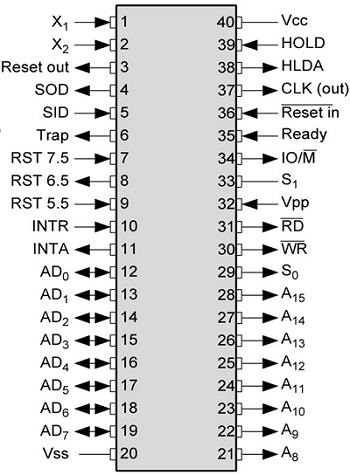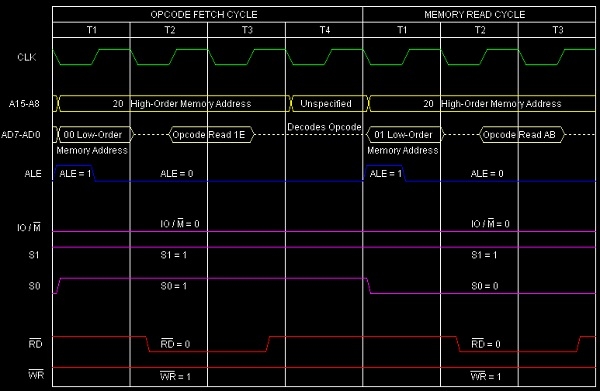
 Data Structure
Data Structure Networking
Networking RDBMS
RDBMS Operating System
Operating System Java
Java MS Excel
MS Excel iOS
iOS HTML
HTML CSS
CSS Android
Android Python
Python C Programming
C Programming C++
C++ C#
C# MongoDB
MongoDB MySQL
MySQL Javascript
Javascript PHP
PHP
- Selected Reading
- UPSC IAS Exams Notes
- Developer's Best Practices
- Questions and Answers
- Effective Resume Writing
- HR Interview Questions
- Computer Glossary
- Who is Who
A15-8 pins in 8085 Microprocessor
The Intel 8085 ("eighty-eighty-five") is an 8-bit microprocessor produced by Intel and introduced in 1976. It is a software-binary compatible with the more-famous Intel 8080 with only two minor instructions added to support its added interrupt and serial input/output features. Intel 8085 can read or write 8 bits at a time. Also, memory is used for storing data and results, 8 bits in each memory location. Like two memory locations and four memory locations, if there are eight memory locations, 3-bit address is needed to specify the location of interest. If address is 000, location 0 is selected, etc. and if address is 111, location 7 is selected. On A15-8 the 8085 sends out the MS byte of address. These are o/p tri-state (a state of high impedance) signals used as higher order 8 bits of 16-bit address. Their pin numbers are 28 to 21, respectively in the pin diagram of 8085 microprocessor. These signals are unidirectional and are given from 8085 to select memory or I/O devices. With 16 address pins the 8085 is capable of addressing any memory location out of 216 = 26×210 = 64×1024 = 65,536 locations.

Fig: Pin diagram of 8085
Let us consider this following example and also the voltage levels at AD15, AD14, …, AD8 pins. If we consider instruction MVI E, ABH then it means that ABH will be moved or copied to the register E. And as a result, the previous value of E will get over written.
| Address |
Hex Codes |
Mnemonic |
Comment |
|---|---|---|---|
| 2000 |
1E |
MVIE, ABH |
E ← ABH |
| 2001 |
AB |
|
ABH as operand |
This instruction will have seven T-states as shown below.

Summary − So this instruction MVI E, ABH requires 2-Bytes, 2-Machine Cycles Opcode Fetch and Memory Read) and 7 T-States for execution as shown in the timing diagram.

